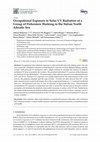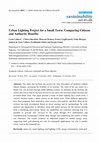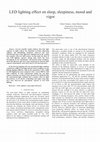Papers by Chiara Burattini
Advances in Science, Technology and Engineering Systems Journal

International Journal of Environmental Research and Public Health
Solar Ultra-Violet (UV) radiation has positive and negative effects on human body tissues. Small ... more Solar Ultra-Violet (UV) radiation has positive and negative effects on human body tissues. Small doses of solar UV radiation are needed by the human skin for the activation of the vitamin D production. Overexposure to solar UV radiation can produce acute and long-term negative effects, such as sunburns and, in the worst cases, cataracts and skin cancers. For this reason, knowing the amount of UV doses received by people is essential to evaluate their risk to UV overexposure and to evaluate the adequate countermeasure to avoid the negative effects. The original contribution of the present study consists in having searched, collected, adapted and processed a series of technical information and analytical relations, developing an algorithm suitable for the calculation of the erythemal UV dose on sloped surfaces exposed to solar radiation, which at the moment is not present in the scientific literature. The results obtained by the algorithm have been compared to the results of a field m...
Building Research & Information

International Journal of Environmental Research and Public Health
Occupational solar radiation exposure is a relevant heath risk in the fishing sector. Our aim was... more Occupational solar radiation exposure is a relevant heath risk in the fishing sector. Our aim was to provide a detailed evaluation of individual UV exposure in three different fishing activities in Italy, with personal UV dosimeters and a simple formula to calculate the fraction of ambient erythemal UV dose received by the workers. The potential individual UV exposure of the fishermen was between 65 and 542 Joules/m2. The percentages of the ambient exposure were estimated between 2.5% and 65.3%. Workers’ UV exposure was mainly influenced by the characteristics of the work activity, the postures adopted, and the type of boats. Overall, our data showed that 43% of the daily measurements could result largely above the occupational limits of 1–1.3 standard erythemal dose (i.e., 100 Joules/m2) per day, in case of exposure of uncovered skin areas. Measurements of individual UV exposure are important not only to assess the risk but also to increase workers’ perception and stimulate the ado...

Building and Environment
Previous studies demonstrated that both light intensity and spectral composition of light impact ... more Previous studies demonstrated that both light intensity and spectral composition of light impact on brain functioning and regulate circadian rhythms. Further, several studies have shown that light exposure, especially blue light (about 460 nm), has positive effects on alertness, vigilance, mood, also increasing mental performance and work productivity. Unfortunately, results have not been always consistent. This study investigated the effect of different lighting conditions on attention with an experiment examining the impact of correlated colour temperature (CCT) on visual and acoustic vigilance. The performance of forty participants (20 men), aged from 20 to 35 years, was investigated under warm (3000 K) or cold (6800) white LED lighting conditions: under these conditions they executed a cross-modal vigilance task and filled in the Karolinska Sleepiness Scale (KSS) and the Global Vigor and Affect (GVA) scale. Results showed a positive effect of cold light on visual vigilance and absence of effects on acoustic vigilance. Specifically, a significant effect of the cold lighting condition was found in the visual response times (RT): participants in the experimental group when executing the task with 6800 K LED maintained the same visual vigilance level and did not experience the natural vigilance decrement, as occurred to the control group under 3000 K LED Furthermore, no effects were observed on sleepiness and vigour-mood self-assessments. A hypothesis of the possible reason for this modality-specific effect could rely on different neural bases involved in visual versus auditory signals.

Sustainability, 2015
The smart and resilient city evolves by slow procedures of mutation without radical changes, incr... more The smart and resilient city evolves by slow procedures of mutation without radical changes, increasing the livability of its territory. The value of the city center in a Smart City can increase through urban lighting systems: its elements on the territory can collect and convey data to increase services to city users; the electrical system becomes the so-called Smart Grid. This paper presents a study of smart lighting for a small town, a touristic location inside a nature reserve on the Italian coast. Three different approaches have been proposed, from minimal to more invasive interventions, and their effect on the territory has been investigated. Based on street typology and its surroundings, the work analyzes the opportunity to introduce smart and useful services for the citizens starting from a retrofitting intervention. Smart city capabilities are examined, showing how it is possible to provide new services to the cities through ICT (Information and Communication Technology) without deep changes and simplifying the control of basic city functions. The results evidence an important impact on annual energy costs, suggesting smart grid planning not only for metropolis applications, but also in smaller towns, such as the examined one.

International Journal of Environmental Research and Public Health
Solar Ultra-Violet (UV) radiation has positive and negative effects on human body tissues. Small ... more Solar Ultra-Violet (UV) radiation has positive and negative effects on human body tissues. Small doses of solar UV radiation are needed by the human skin for the activation of the vitamin D production. Overexposure to solar UV radiation can produce acute and long-term negative effects, such as sunburns and, in the worst cases, cataracts and skin cancers. For this reason, knowing the amount of UV doses received by people is essential to evaluate their risk to UV overexposure and to evaluate the adequate countermeasure to avoid the negative effects. The original contribution of the present study consists in having searched, collected, adapted and processed a series of technical information and analytical relations, developing an algorithm suitable for the calculation of the erythemal UV dose on sloped surfaces exposed to solar radiation, which at the moment is not present in the scientific literature. The results obtained by the algorithm have been compared to the results of a field m...
Procedia Engineering, 2015

Adding titanium to a hot-dip galvanising bath, a coloured oxide film due to interference effect w... more Adding titanium to a hot-dip galvanising bath, a coloured oxide film due to interference effect was obtained on iron samples; different colours were achieved varying the bath temperature in the range of 520–600°C. In this paper, the resistance of three colours (yellow, purple and light blue) to four corrosive environments (urban, marine, industrial and rural) has been investigated by means of an experimental approach: two specimens of each colour with titanium percentage of 0.2% were exposed for 1 year in each environment and colour measurements in CIE Lab coordinates have been recorded at fixed time intervals. Modification of colours on samples due to corrosion effects of different chemical agents was evaluated calculating CIE colour difference.
Results demonstrated that the colour of the coatings have a good resistance to all kinds of atmospheres tested; so the performance of this galvanising bath resulted adequate for architectural application.

—Due to the increasing amount of energy consumption and CO2 emissions, Building Automation System... more —Due to the increasing amount of energy consumption and CO2 emissions, Building Automation Systems have been developed in order to increase energy performance in buildings and guarantee indoor comfort at the same time. However, along with the development of the hardware itself, the need to develop also suitable control systems and methods for improving the management of smart buildings, is arising. In this framework, fuzzy logic may be a valuable tool for developing suitable control systems. In this paper, fuzzy logic has been used in order to optimize comfort features and energy demand in an office. Starting from the model defined in a previous work, the aim of the paper is to simulate different configurations of the room and compare the results in order to evaluate the impact of room variations (window geometry, glass properties and wall reflectance) on the fuzzy control system. Given the same solar radiation inputs, it was noticed that different room configurations require a diversified management of the shading systems and artificial lighting control in order to achieve a good balance between comfort and energy consumption.
— The elevated lighting demand in tunnel's portal zone to guarantee drivers eye adaptation to the... more — The elevated lighting demand in tunnel's portal zone to guarantee drivers eye adaptation to the internal luminance has been the subject of previous studies exploring the opportunity to gradually introduce daylight in the threshold zone and thus reduce consumption. A 1:10 scale model of this adaptation zone, called daylight " filter " structure, has been constructed to investigate uniformity and luminance reduction under panels with different percentages of holed ceiling surface. The trend of the luminance curve compared to CIE curve of luminance led to the optimization of panels' position along the tunnel. Results confirmed the possibility of implementing drivers' vision introducing daylight through the " filter " structure.

—Several scientific studies indicate that blue light exposure at night reduces the melatonin secr... more —Several scientific studies indicate that blue light exposure at night reduces the melatonin secretion, improving vigilance and diminishing sleepiness; moreover has been demonstrated that a blue light dose administered in the evening has a positive effect for shift workers. In this study the effect of cool LED lighting exposure during daily hours has been investigated in two experiments: self-reported sleep, sleepiness, mood and physical vigor have been assessed prior and post light exposure using bipolar scales (KSS and GVAS) and sleep diary. In the first investigation (E1) the experimental light condition consisted in a 4000 K LED light and the control condition was the halogen lighting (2800 K); while in the experiment 2 (E2) a 6800 K LED lighting has been compared with a warm 3000 K LED light condition. In both experimental studies the cool light exposure duration was about 1 hour. Results of E1 indicated that the experimental light condition had a positive effect on night sleep latency; in E2 shorter awakenings and longer sleep time have been observed for participants exposed to cool LED lighting.
Journal of the British Interplanetary Society
ABSTRACT

Among the many differences between the extra-atmospheric and the terrestrial environment, microgr... more Among the many differences between the extra-atmospheric and the terrestrial environment, microgravity is what mainly conditions human being life, because it influences the way of space perceiving and of acting inside of it. Moving inside a Space module in lack of gravity can cause astronaut's disorientation because the six surfaces have the same aspect and in Space doesn't exist, as on Earth, a prevalent direction of positioning generated by gravity: a strategy to avoid that a Space Station becomes a labyrinth, within which proves undistinguishable the floor from the ceiling and the right from the left wall, is use of color to characterize different surfaces. Given the importance that color has in human life, as in psychology area for its capability of conditioning moods and behaviors, as in physiology area because affecting circadian rhythm, the use of color in the interior design requires a particular attention. The characterization of an architectonic space with color is...

Recent studies showed the non-visual effects of the exposure to blue light on human physiology an... more Recent studies showed the non-visual effects of the exposure to blue light on human physiology and psychology: positive effects on circadian rhythms, alert, vigilance and also on cognitive processes and mood regulation; but few works investigated the effects of blue light exposure on executive functions. The inhibitory processes, specific aspects of the executive functions, have relevance in daily life and may be crucial for jobs like air-traffic controller. We investigated the effects of new LED sources, rich in blue spectrum, in a real environment in which light setting has been carefully projected, 44 College students performed a Switching Task, in which inhibitory processes and switch cost were measured. Results suggest that blue light exposure improves the cognitive system’s capacity to deal with multiple task representations, which might remain active simultaneously without interfering with each other. Results of present study reserve some possible implications for air-traffic...

Uploads
Papers by Chiara Burattini
Results demonstrated that the colour of the coatings have a good resistance to all kinds of atmospheres tested; so the performance of this galvanising bath resulted adequate for architectural application.
Results demonstrated that the colour of the coatings have a good resistance to all kinds of atmospheres tested; so the performance of this galvanising bath resulted adequate for architectural application.